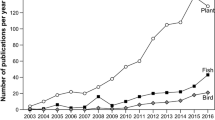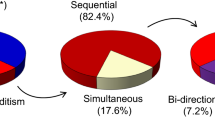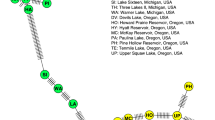Abstract
The parallel evolution of similar ecotypes in response to comparable environmental conditions is believed to reveal the importance of divergent selection in phenotypic diversifying processes. Systems characterized by the presence of multiple replicate populations expressing resource polymorphism thus provide an ideal opportunity to address the occurrence and factors affecting the parallel evolution of ecotypes. Previous studies have shown that brook charr (Salvelinus fontinalis) exhibit resource polymorphism in some Canadian Shield lakes, where a littoral ecotype feeds mainly on zoobenthos and a pelagic ecotype feeds mostly on zooplankton. Using morphological traits and geometric morphometric analyses on 18 native brook charr populations, we explicitly tested (i) whether brook charr ecotypes show parallel evolution across populations (i.e. the same morphological traits discriminate ecotypes among lakes) and (ii) whether interspecific competition decreases the amplitude of morphological differentiation between ecotypes, if any, because brook charr experience some level of competitive exclusion from the littoral habitat in the presence of creek chub or white sucker. We observed a low level of parallel evolution, where the littoral ecotype was overall stouter with longer fins and smaller eyes than the pelagic ecotype. Interspecific competition had no clear impacts on the amplitude of morphological differentiation. We also observed that inter-lake morphological differences are greater than between ecotypes within lakes, suggesting an important effect of local environmental factors on population morphology. Early-stage of diversification as well as phenotypic plasticity and morphological integration could explain why resource polymorphism is still subtle in brook charr populations.





Similar content being viewed by others
References
Adams DC (2010) Parallel evolution of character displacement driven by competitive selection in terrestrial salamanders. BMC Evol Biol 72:1–10. https://doi.org/10.1186/1471-2148-10-72
Adams DC, Collyer ML, Kaliontzopoulou A (2019) Geomorph: Software for geometric morphometric analyses. R package version 4.0.0. https://cran.r-project.org/package=geomorph. Accessed 16 June 2021
Angers B, Bernatchez L (1998) Combined use of SMM and non-SMM methods to infer fine structure and evolutionary history of closely related brook charr (Salvelinus fontinalis, Salmonidae) populations from microsatellites. Mol Biol Evol 15:143–159
Arbour J, Hardie D, Hutchings JA (2010) Morphometric and genetic analyses of two sympatric morphs of Arctic char (Salvelinus alpinus) in the Canadian High Arctic. Can J Zool 89:19–30
Bertolo A, Pépino M, Adams J, Magnan P (2011) Behavioural thermoregulatory tactics in lacustrine brook charr. Salvelinus Fontinalis Plos One 6:e18603. https://doi.org/10.1371/journal.pone.0018603
Bertrand M, Marcogliese DJ, Magnan P (2008) Trophic polymorphism in brook charr revealed by diet, parasites and morphometrics. J Fish Biol 72:555–572. https://doi.org/10.1111/j.1095-8649.2007.01720.x
Boizard J, Magnan P, Angers B (2009) Effects of dynamic landscape elements on fish dispersal: the example of creek chub (Semotilus atromaculatus). Mol Ecol 18:430–441. https://doi.org/10.1111/j.1365-294X.2008.04044.x
Bolnick DI, Svanbäck R, Fordyce JA, Yang LH, Davis JM, Hulsey CD, Forister ML (2003) The ecology of individuals: incidence and implications of individual specialization. Am Nat 161:1–28. https://doi.org/10.2307/3078879
Borcard D, Gillet F, Legendre P (2011) Numerical ecology with R. Springer, New York
Bourke P, Magnan P, Rodriguez MA (1996) Diel locomotor activity of brook charr, as determined by radiotelemetry. J Fish Biol 49:1174–1185. https://doi.org/10.1006/jfbi.1996.0245
Bourke P, Magnan P, Rodriguez MA (1997) Individual variations in habitat use and morphology in brook charr. J Fish Biol 51:783–794. https://doi.org/10.1006/jfbi.1997.0481
Bourke P, Magnan P, Rodriguez MA (1999) Phenotypic responses of lacustrine brook charr in relation to the intensity of interspecific competition. Evol Ecol 13:19–31
Collyer ML, Adams DC (2013) Phenotypic trajectory analysis: comparison of shape change patterns in evolution and ecology. Hystrix It J Mamm 24:75–83. https://doi.org/10.4404/hystrix-24.1-6298
Collyer ML, Adams DC (2018) RRPP: an R package for fitting linear models to high-dimensional data using residual randomization. Methods Ecol Evol 78:43–49. https://doi.org/10.1111/2041-210X.13029
Collyer ML, Sekora DJ, Adams DC (2015) A method for analysis of phenotypic change for phenotypes described by high-dimensional data. Heredity 115:357–365. https://doi.org/10.1038/hdy.2014.75
Dermond P, Sperlich N, Brodersen J (2019) Heritable morphological differentiation in salmonids from two distinct stream types. J Fish Biol 95:1215–1222. https://doi.org/10.1111/jfb.14121
Dynes J, Magnan P, Bernatchez L, Rodriguez MA (1999) Genetic and morphological variation between two forms of lacustrine brook charr. J Fish Biol 54:955–972
Fleming IA, Jonsson B, Gross MR (1994) Phenotypic divergence of sea-ranched, farmed, and wild salmon. Can J Fish Aquat Sci 51:2808–2824
Friendly M, Fox J (2017) candisc: visualizing generalized canonical discriminant and canonical correlation analysis. R package version 08-5. https://CRAN.R-project.org/package=candisc. Accessed 16 June 2021
Gatz AJ (1979) Community organisation in fishes as indicated by morphological features. Ecology 60:711–718
Goyer K, Bertolo A, Pépino M, Magnan P (2014) Effects of lake warming on behavioural thermoregulatory tactics in a cold-water stenothermic fish. PLoS ONE 9:e92514. https://doi.org/10.1371/journal.pone.0092514
Hendry A (2009) Ecological speciation! Or the lack thereof? Can J Fish Aquat Sci 66:1383–1398. https://doi.org/10.1139/F09-074
Hugall AF, Stuart-Fox D (2012) Accelerated speciation in colour-polymorphic birds. Nature 485:631–634. https://doi.org/10.1038/nature11050
Jacobs A, Carruthers M, Yurchenko A, Gordeeva NV, Alekseyev SS, Hooker O, Leong JS, Minkley DR, Rondeau EB, Koop BF, Adams CE, Elmer KR (2020) Parallelism in eco-morphology and gene expression despite variable evolutionary and genomic backgrounds in a Holarctic fish. PLoS Genet 16:e1008658. https://doi.org/10.1371/journal.pgen.1008658
Kotrschal K (1989) Trophic ecomorphology in eastern Pacific blennioid fishes: character transformation of oral jaws and associated change of their biological roles. Environ Biol Fishes 24:199–218
Lacasse S, Magnan P (1993) Distribution post-glaciaire des poisson dans le bassin hydrographique du fleuve Saint-Laurent: impact des interventions humaines. Université de Trois-Rivières pour le ministère du Loisir, de la Chasse et de la Pêche du Québec, Québec, Canada
Lacasse S, Magnan P (1992) Biotic and abiotic determinants of the diet of brook trout, Salvelinus fontinalis, in lakes of the Laurentian Shield. Can J Fish Aquat Sci 49:1001–1009
Lachance S, Magnan P (1990) Performance of domestic, hybrid, and wild strains of brook trout, Salvelinus fontinalis, after stocking: the impact of intra- and interspecific competition. Can J Fish Aquat Sci 47:2278–2284. https://doi.org/10.1139/f90-253
Lance RF, Kennedy ML, Leberg PL (2000) Classification bias in discriminant function analyses used to evaluate putatively different taxa. J Mammal 81:245–249
Magnan P (1988) Interaction between brook charr, Salvelinus fontinalis, and nonsalmonid species: ecological shift, morphological shift, and their impact on zooplankton communities. Can J Fish Aquat Sci 45:999–1009
Magnan P, Proulx R, Plante M (2005) Integrating the effects of fish exploitation and interspecific competition into current life history theories: an example with lacustrine brook trout (Salvelinus fontinalis) populations. Can J Fish Aquat Sci 62:747–757. https://doi.org/10.1139/F05-041
Malmquist HJ, Snorrason SS, Skúlason S, Jonsson B, Sandlund OT, Jónasson PM (1992) Diet differentiation in polymorphic Arctic charr in Thingvallavatn, Iceland. J Anim Ecol 61:21–35
Martin RA, Pfennig DW (2010) Field and experimental evidence that competition and ecological opportunity promote resource polymorphism. Biol J Linn Soc 100:73–88. https://doi.org/10.1111/j.1095-8312.2010.01380.x
Norton SF (1991) Capture success and diet of cottid fishes: the role of predator morphology and attack kinematics. Ecology 72:1807–1819
Oke KB, Rolshausen G, LeBlond C, Hendry AP (2017) How parallel is parallel evolution? A comparative analysis in fishes. Am Nat 190:1–16. https://doi.org/10.1086/691989
Olden JD, Jackson DA, Peres-Neto PR (2002) Predictive models of fish species distributions: a note on proper validation and chance predictions. Trans Am Fish Soc 131:329–336
Østbye K, Amundsen PA, Bernatchez L, Klemetsen A, Knudsen R, Kristoffersen R, Næsje TF, Hindar K (2006) Parallel evolution of ecomorphological traits in the European whitefish Coregonus lavaretus (L.) species complex during postglacial times. Mol Ecol 15:3983–4001. https://doi.org/10.1111/j.1365-294X.2006.03062.x
Pépino M, Magnan P, Proulx R (2018) Field evidence for a rapid adaptive plastic response in morphology and growth of littoral and pelagic brook charr: a reciprocal transplant experiment. Funct Ecol 32:161–170. https://doi.org/10.1111/1365-2435.12929
Peres-Neto PR, Magnan P (2004) The influence of swimming demand on phenotypic plasticity and morphological integration: a comparison of two polymorphic charr species. Oecologia 140:36–45. https://doi.org/10.1007/s00442-004-1562-y
Pounder KC, Mitchell JL, Thomson JS, Pottinger TG, Sneddon LU (2018) Physiological and behavioural evaluation of common anaesthesia practices in the rainbow trout. Appl Anim Behav Sci 199:94–102
Proulx R, Magnan P (2002) Physiological performance of two forms of lacustrine brook charr, Salvelinus fontinalis, in the open-water habitat. Environ Biol Fishes 64:127–136
Proulx R, Magnan P (2004) Contribution of phenotypic plasticity and heredity to the trophic polymorphism of lacustrine brook charr (Salvelinus fontinalis M.). Evol Ecol Res 6:503–522
R Development Core Team (2014) R: A language and environment for statistical computing. Vienna, Austria: R Foundation for Statistical Computing. Retrieved from https://www.r-project.org
Rainville V, Filion A, Lussier I, Pépino M, Magnan P (2021) Does ecological release from distantly related species affect phenotypic divergence in brook charr? Oecologia 195:77–92. https://doi.org/10.1007/s00442-020-04822-6
Reist JD (1986) An empirical evaluation of coefficients used in residual and allometric adjustment of size covariation. Can J Zool 64:1363–1368
Rice AM, Leichty AR, Pfennig DW (2009) Parallel evolution and ecological selection: replicated character displacement in spadefoot toads. Proc R Soc B 276:4189–4196. https://doi.org/10.1098/rspb.2009.1337
Robinson BW, Parsons KJ (2002) Changing times, spaces, and faces: tests and implications of adaptive morphological plasticity in the fishes of northern postglacial lakes. Can J Fish Aquat Sci 59:1819–1833. https://doi.org/10.1139/f02-144
Robinson BW, Wilson DS (1994) Character release and displacement in fishes: a neglected literature. Am Nat 144:596–627
Rohlf FJ, Marcus L (1993) A revolution in morphometrics. Trends Ecol Evol 8:129–132. https://doi.org/10.1016/0169-5347(93)90024-J
Rohlf FJ, Slice DE (1990) Extensions of the Procrustes method for the optimal superimposition of landmarks. Syst Zool 39:40–59
Rohlf FJ (2012a) tpsDig2, Version 2.16 [computer program]. Department of Ecology and Evolution. State University of New York, Stony Brook. https://life.bio.sunysb.edu/morph/. Accessed 15 Jan 2013
Rohlf FJ (2012b) tpsUtil, Version 1.57 [computer program]. Department of Ecology and Evolution. State University of New York, Stony Brook. https://life.bio.sunysb.edu/morph/. Accessed 15 Jan 2013
Rouleau S, Glémet H, Magnan P (2010) Effects of morphology on swimming performance in wild and laboratory crosses of brook trout ecotypes. Funct Ecol 24:310–321. https://doi.org/10.1111/j.1365-2435.2009.01636.x
Sacotte S, Magnan P (2006) Inherited differences in foraging behaviour in the offspring of two forms of lacustrine brook charr. Evol Ecol Res 8:843–857
Samways KM, Leavitt PR, Magnan P, Rodriguez MA, Peres-Neto PR (2015) Convergent polymorphism between stream and lake habitats: the case of brook char. Can J Fish Aquat Sci 72:1406–1414
Schluter D (2000) The ecology of adaptive radiation. Oxford University Press, Oxford
Sigursteinsdóttir RJ, Kristjánsson BK (2005) Parallel evolution, not always so parallel: comparison of small benthic charr, Salvelinus alpinus, from Grímsnes and Thingvallavatn, Iceland. Environ Biol Fishes 74:239–244. https://doi.org/10.1007/s10641-005-0499-2
Skúlason S, Parsons KJ, Svanbäck R, Räsänen K, Ferguson MM, Adams CE, Amundsen PA, Bartels P, Bean CW, Boughman JW, Englund G, Guðbrandsson J, Hooker OE, Hudson AG, Kahilainen KK, Knudsen R, Kristjánsson BK, Leblanc CAL, Jónsson Z, Öhlund G, Smith C, Snorrason SS (2019) A way forward with eco evo devo: an extended theory of resource polymorphism with postglacial fishes as model systems. Biol Rev 94:1786–1808. https://doi.org/10.1111/brv.12534
Smith TB (1997) Adaptive significance of the mega-billed form in the polymorphic black-bellied seedcracker Pyrenestes ostrinus. Nature 139:382–387
Smith DA, Ridgway MS (2019) Temperature selection in brook charr: lab experiments, field studies, and matching the fry curve. Hydrobiologia 840:143–156. https://doi.org/10.1007/s10750-018-3869-4
Smith TB, Skúlason S (1996) Evolutionary significance of resource polymorphisms in fishes, amphibians, and birds. Annu Rev Ecol Evol Syst 27:111–133
Tremblay S, Magnan P (1991) Interactions between two distantly related species, brook trout (Salvelinus fontinalis) and white sucker (Catostomus commersoni). Can J Fish Aquat Sci 48:857–867
Venables WN, Ripley BD (2002) Modern applied statistics with S, 4th edn. Springer, New York (ISBN 0-387-95457-0)
Wainwright PC, Richard BA (1995) Predicting patterns of prey use from morphology of fishes. Environ Biol Fishes 44:97–113
Walker JA (1997) Ecological morphology of lacustrine threespine stickleback Gasterosteus aculeatus L. (Gasterosteidae) body shape. Biol J Linn Soc 61:3–50
Webb PW (1984) Body form, locomotion and foraging in aquatic vertebrates. Am Zool 24:107–120
Wetzel RG, Likens GE (2000) Limnological analyses, 3rd edn. Springer-Verlag, New York
Winemiller KO (1991) Eco-morphological diversification in lowland freshwater fish assemblages from five biotic regions. Ecol Monogr 61:343–365
Wismer DA, Christie AE (1987) Temperature relationships of Great Lakes fishes: a data compilation. Great Lakes Fishery Commission, Ann Arbor (Special Publication No. 87–3)
Zuur AF, Ieno EN, Smith GM (2007) Analysing ecological data. Springer, New York
Acknowledgements
We thank the numerous students and research assistants involved in this project for their invaluable field and laboratory assistance: Dominic Bélanger, Ariane Bisson, Patricia Bolduc, Pierre-André Bordeleau, Alexandre East, Antoine Fillion, Chantal Fournier, Natalie Godbout, Winna Landry, Benjamin Laramée, Roger Levasseur, Isabelle Lussier, Maya Petit, Stéphanie Plourde, Pierre Rigalleau, Timothée Rivault-Guillard, and David Schelling. We also thank Olivier Roy and David Schelling from Mastigouche and St. Maurice Wildlife reserves as well as Michel Plante from La Mauricie National Park for their assistance with logistics. Laure Devine, the Handling Editor, Brian Shuter and two anonymous referees provided helpful comments on an earlier version of the paper. This work was supported by grants from Natural Sciences and Engineering Research Council of Canada (NSERC) and the Canada Research Chair Program to P.M. V.R. was supported by a scholarship from the Fonds de recherche du Québec—Nature et technologies (FRQNT) du Québec.
Author information
Authors and Affiliations
Contributions
PM originally formulated the idea. VR and MP conducted fieldwork. VR wrote the first draft of the manuscript. All authors were involved in data analyses, contributed critically to the drafts, and gave final approval for publication.
Corresponding author
Additional information
Communicated by Brian Shuter.
Supplementary Information
Below is the link to the electronic supplementary material.
Rights and permissions
About this article
Cite this article
Rainville, V., Pépino, M. & Magnan, P. Parallel evolution of morphological traits and body shape in littoral and pelagic brook charr, Salvelinus fontinalis, along a gradient of interspecific competition. Oecologia 197, 421–436 (2021). https://doi.org/10.1007/s00442-021-05028-0
Received:
Accepted:
Published:
Issue Date:
DOI: https://doi.org/10.1007/s00442-021-05028-0




